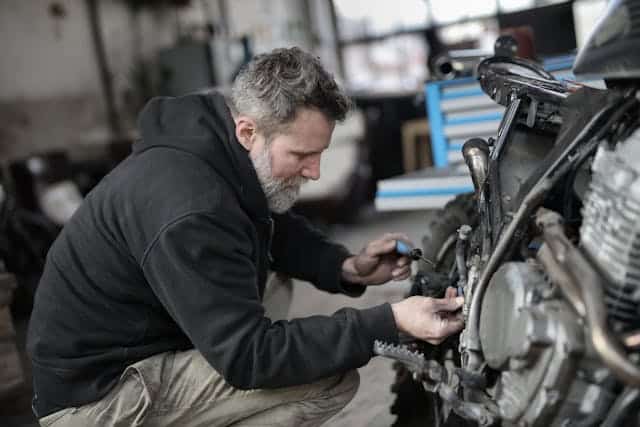7 essential task to Motorcycle Maintenance – bonus tips

Owning a motorcycle is not just about the thrill of riding; it’s also about taking care of your machine to ensure it performs well and lasts long. Proper maintenance is crucial to keeping your motorcycle in optimal condition, whether you ride occasionally or every day. This guide covers essential motorcycle maintenance tasks, tips, and best practices to help you preserve your motorcycle’s longevity.
Importance of Motorcycle Maintenance
Regular maintenance not only extends the lifespan of your motorcycle but also enhances safety and performance. Neglecting maintenance can lead to costly repairs, breakdowns, and compromised safety on the road. By investing time and effort into upkeep, you can enjoy smoother rides, lower repair costs, and peace of mind knowing your motorcycle is in top shape.
Essential motorcycle Maintenance Tasks
1. Regular Inspections
Routine inspections are the foundation of motorcycle maintenance. Conduct these checks before and after rides to identify potential issues early:
- Tires: Check tread depth, pressure (when cold), and look for signs of wear or damage.
- Brakes: Inspect brake pads, discs, and fluid levels regularly for proper function.
- Lights, Signals, and Horn: Ensure all lights, including headlights, brake lights, turn signals, and horn are working correctly.
- Fluid Levels: Monitor oil, coolant, brake fluid, and hydraulic fluid levels regularly.
- Chain: Lubricate and adjust the chain tension according to manufacturer recommendations.
- Battery: Check battery terminals for corrosion and ensure proper charge.
2. Oil and Filter Changes
Regular oil changes are vital for engine health. Follow the manufacturer’s recommended intervals and use high-quality oil and filters. Fresh oil lubricates moving parts, reduces friction, and prevents premature wear.
3. Chain Maintenance
The chain transfers power from the engine to the rear wheel and requires regular care:
- Cleaning: Clean the chain with a brush and solvent to remove dirt and grime.
- Lubrication: Apply chain lubricant after cleaning and wipe off excess to prevent flinging.
- Tension: Check and adjust chain tension to prevent slack, which can damage sprockets.
4. Brake System
Maintaining brakes is crucial for rider safety:
- Pads and Discs: Replace brake pads when worn and inspect brake discs for wear and warping.
- Fluid: Flush and replace brake fluid according to manufacturer recommendations to maintain braking performance.
5. Cooling System
Ensure the cooling system operates efficiently to prevent overheating:
- Coolant: Check coolant levels and condition regularly. Replace coolant as recommended by the manufacturer.
- Radiator: Keep the radiator clean and free from debris to maintain proper cooling.
6. Electrical System
A well-maintained electrical system ensures reliable starting and operation:
- Battery: Monitor battery health, charge regularly, and replace as needed.
- Wiring and Connections: Inspect wiring harnesses and connections for wear, corrosion, or loose connections.
7. Suspension and Steering
Maintain suspension and steering components for smooth handling and stability:
- Fork Oil: Check fork oil levels and condition. Replace fork seals if leaking.
- Steering Bearings: Ensure steering bearings are properly adjusted and lubricated.
Seasonal motorcycle Maintenance
1. Winter Storage Preparation
If you store your motorcycle during winter or extended periods:
- Fuel: Use a fuel stabilizer and fill the tank to prevent condensation and fuel degradation.
- Battery: Remove the battery or use a maintainer to keep it charged.
- Tires: Inflate tires to recommended pressure and consider using stands to prevent flat spots.
2. Spring Readiness
Prepare your motorcycle for the riding season:
- Fluids: Check all fluid levels and top up or replace as necessary.
- Tires: Inspect tires for wear, cracks, or dry rot. Replace if needed.
- Brakes: Test brakes for proper operation and adjust if necessary.
bonus Advanced motorcycle Maintenance Tips
1. Valve Clearance Adjustment
Some motorcycles require periodic valve clearance adjustments. Refer to the service manual for intervals and procedures.
2. Carburetor and Fuel Injection Cleaning
Clean carburetors or fuel injectors regularly to ensure proper fuel delivery and engine performance.
3. Chain and Sprocket Replacement
Replace chains and sprockets when they reach the end of their service life to prevent drivetrain damage.
DIY vs. Professional Maintenance
While basic motorcycle maintenance tasks can often be performed at home with the right tools and knowledge, some jobs require professional expertise:
- DIY: Oil changes, chain maintenance, basic inspections.
- Professional: Valve adjustments, complex electrical diagnostics, major engine work.
Conclusion
Proper maintenance is the key to maximizing the lifespan of your motorcycle and ensuring it performs reliably mile after mile. By following manufacturer guidelines, conducting regular inspections, and addressing issues promptly, you can enjoy safe and enjoyable rides for years to come. Whether you’re a novice or experienced rider, dedicating time to maintain your motorcycle pays off in the long run with enhanced performance, reduced repair costs, and increased safety on the road.
For a detailed guide on motorcycle maintenance, you can check out this resource: Motorcycle Maintenance on RevZilla’s Common Tread blog.



